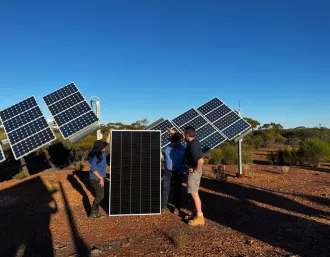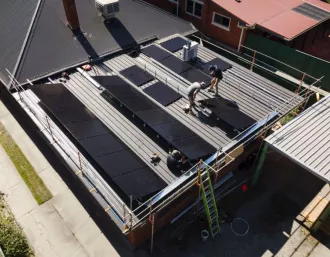10 simple ways to reduce business energy costs

You might not think much about paying your electric bill every month. And if you do, well, that's just the cost of doing business, right? Not exactly. Take a moment to consider the energy you're likely paying for that room in your office no one ever seems to use, and you'll definitely want to learn how to reduce your business energy costs.
The fact is, depending on the size of your organisation and facilities, you can lower your electric bill by thousands of dollars every month just by following a few easy steps to increase the energy efficiency of your offices. Here's a rundown of the specific tips and simple changes you can make that can add up to short-term and long-term energy savings.
- Get an energy audit
Nothing gets the heart racing like the word "audit." While this might not sound like a good thing at first, when it comes to your business energy costs and usage, it really is. Getting a report from a qualified energy auditor can help you figure out where your money is going every month, how to increase energy efficiency and how to lower electric bills. - When not in use, turn off lights and equipment
This step might seem obvious, but you'd be surprised how much energy all those computers, monitors, printers and other devices consume while setting there unused but still left on. By making sure they're in "sleep mode" or turned off completely overnight, you won't be paying for electricity you're not even using. Make it someone's nightly routine to take a quick tour of the office and flip the OFF switch on idle equipment. The same goes for breakroom devices such as microwaves, coffeemakers, radios and TVs. One tip is to plug all these energy vampires into a single powerstrip, so you can turn them off at the same time on your way out the door. - Take advantage of natural sunlight as often as you can
Let the sunshine in! Open the blinds around your workspaces to make the best use of daylight—and take advantage of skylights or other natural light sources to reduce your lighting needs during daytime hours. It's also worthwhile to see whether there are areas of your office that are overly lit and remove any lighting that might not be necessary. - Install long-lasting compact fluorescent light (CFL) or light-emitting diode (LED) bulbs
This is one step where saving a little bit in a lot of places can really add up. Replacing a single 60-watt bulb with an 18-watt energy-efficient bulb that's on for 10 hours a day can easily save a business $1 or more each month. Multiply that out to an entire year—and by the hundreds (if not thousands) of bulbs in your business—and you're talking about some serious savings. Energy-efficient bulbs aren't just a smart answer about how to lower electric bills in the short term. Their extended service life will help you save in the long term, too. Energy Star LED light bulbs not only use at least 75% less energy, they can last 50 times longer than the average incandescent—up to 20 years. - Use motion detectors and automatic dimmers that adjust to your needs
Believe it or not, lighting accounts for 18–40% of electricity usage in commercial premises. So, being even just a little bit smarter about when, where and how you use the lighting in your building(s) can add up to big savings. Consider installing motion detectors in hallways, meeting spaces and other places where "always-on" isn't always needed—along with automatic dimming controllers that measure and adjust to the light levels you actually need. - Install programmable thermostats, and use them wisely
A programmable thermostat gives you the power to automatically adjust the temperature of your workplace when no one's there (e.g., most nights, weekends and holidays). Set yours to turn the air-con or heat on 30 minutes before people arrive and off 30 to 60 minutes before they leave. In warmer weather months, it's a good idea to set your thermostat no lower than 25 degrees during office hours in order to reduce energy use. Then, during cooler weather periods, set your thermostat no higher than 20 degrees. - Keep the heat in (or out) with screens, film and weather-stripping
While you might think that gentle breeze from your conference room window isn't a big deal, it's really money and energy flying right out the building—and it's too easy a fix to ignore. Add or replace weather-stripping, caulk or foam around your windows and doors to save energy. Drafts aren't the only way windows can cost you energy and money, however. Windows let in the sun's light and heat, which can make it more expensive to cool your office in warmer weather. Luckily, there are plenty of window treatments that can help your business reduce heat gain and increase energy efficiency, including solar screen window shades, awnings and high-reflectivity window films. - Purchase energy-efficient office equipment
Computers, monitors, printers, fax machines, scanners and copiers with high-star energy ratings can run much more efficiently and automatically power down during extended inactivity. That can help you save 50% or more in energy use on these power-hungry devices. And, if your old heater or air conditioner is not working at maximum efficiency, it could draw unnecessary power, which also costs you money. Replace any old heaters and AC units with higher star-rated models. - Consider alternative and renewable energy sources to help power your business
Using commercial renewable energy sources, such as solar, to power some or all of your business can help lower your business energy costs over time. Doing so also generates power that's free of harmful CO2 emissions and other greenhouse gases. Based on a number of factors, there may never be a better time to invest in solar (or other sources of clean energy) to get the energy your business needs while paying less over the long term. Installing a commercial solar energy storage system can also help. - Keep your HVAC systems running smoothly
Change the filters on your HVAC equipment regularly, and make sure to have the units inspected and cleaned as often as recommended. Keep the areas in front of all vents clear of furniture and paper.
Twenty years ago, if you had asked many business leaders, "What is energy efficiency and how does it impact your bottom line?," you probably would have gotten a lot of blank stares. We've come a long way since then. And while you might believe your business is already doing its part, there's always room to increase your energy efficiency and save even more on your electric bill. Learning how to reduce business energy costs throughout your offices—and using renewable energy sources to generate more of your power—can put your organisation in a much better position to compete and succeed.





